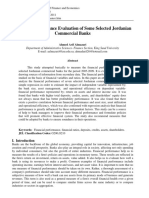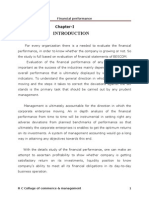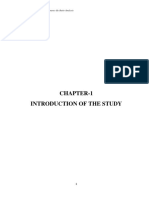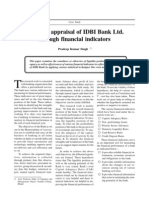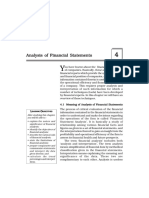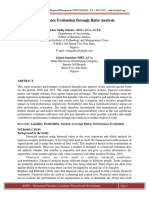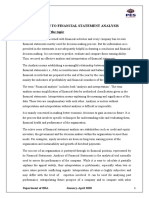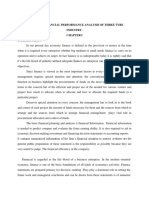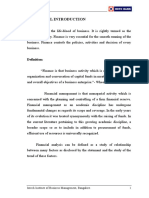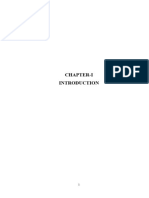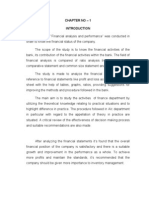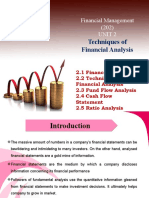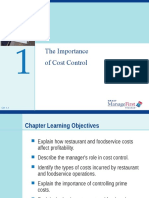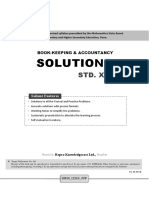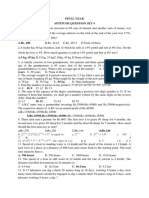Professional Documents
Culture Documents
Evaluation of Financial Performance Analysis of Commercial Bank of Ethiopia
Original Title
Copyright
Available Formats
Share this document
Did you find this document useful?
Is this content inappropriate?
Report this DocumentCopyright:
Available Formats
Evaluation of Financial Performance Analysis of Commercial Bank of Ethiopia
Copyright:
Available Formats
Volume 4, Issue 12, December – 2019 International Journal of Innovative Science and Research Technology
ISSN No:-2456-2165
Evaluation of Financial Performance Analysis of
Commercial Bank of Ethiopia
Yichilal Simegn Filatie
Lecturer, Department of Accounting and Finance
College of Business and Economics
Debre Markos University
Debre Markos, Ethiopia
Abstract:- This study is conducted to evaluate the financial financial statement of a firm used by management creditor,
performance of commercial bank of Ethiopia, in terms of investors and others to make judgment about the operating
Capital adequacy, assets quality, management capability, performance of the firm(Foster G,1978). So, this study
earnings, liquidity and sensitivity to market risk. In this focuses on the evaluation of financial performance of
study the data were collected from secondary data sources. Commercial bank of Ethiopia to measure its profitability and
The secondary data are taken from the audited financial other related risks and also it shows banks strength and
statement of commercial bank of Ethiopia. The collected weakness. Generally, the main purpose of this study is to
data have been analyzed and presented using different measure profitability, liquidity and credit management of
ratios. The findings of the study revealed that the financial commercial bank of Ethiopia, to discussed the financial ratio
performance of the bank for the period under study was measurement and analysis, and also to assess the overall
reasonably good when it is evaluated using audited financial performance and condition of the bank.
financial statements. Since debt is known as a cheapest
source of fund for business entities than other sources, the A. Statement of the Problem
bank shall try to increase debt ratio to a reasonable extent If management of a firm helps to maximize bank
and raise additional finance to expand the business as well performance it takes advantage of the banks strength and
as increase profitability. correct its weaknesses. In this regard the management body of
the bank highly on through figures of financial statement.
Keywords:- Commercial Bank of Ethiopia, Financial However the absolute amount of priority or asset and
Performance, Financial Analysis. liabilities shown in accounts are not usually a particular
meaning full criterion on for evaluating financial performance.
I. INTRODUCTION Appropriate techniques of financial performance evaluations
are rare to see in the bank. Therefore information required for
The evaluation of financial performance was the subject management, like if the bank profitable, whether the bank
of how will a firm can use asset from its primary mode of employs effectively its resource and if the bank borrows
business and generate revenue. If properly analyzed and beyond its capacity or limit (Hempl, G, 1999). At large the
interpreted financial statements could provide valuable insight accounting profession focuses on how financial statement can
into the firm’s performance. Analysis of financial statement is be used for financial performance evaluation. Therefore the
the interest of lenders (short term as well as long term), analyzed financial statement helps the manager to assess the
investors, security analysis, managers and others (Chandra, current, past as well as the future financial strength and
2001). The study emphasis on different aspect that would be weakness of firm and makes appropriate decision (Gitman, L.
considered as key factors for evaluating the financial condition G 2004).
and performance of most business organization, some of these
factors are site and ranking a growth records, financial Accordingly, the study focuses on evaluating the bank’s
performance, and quality of management, location, labor financial performance and financial position both in firm’s
management relations, liquidity, leverage, profitability and position in time and on its operation over the period under
pattern of exiting stock holding. Each of those factors has their study. Furthermore, to the best of the researcher’s knowledge,
own contribution on general growth of company, therefore to only few studies have been conducted on evaluation of
check overall growth of the company consistent evaluation of financial performance of financial institution in Ethiopia in
each factor need to be vital (Sinha, 2010). general and commercial bank of Ethiopia in particular in the
Pre and post financial liberalization. Thus, this study
Financial analysis involves methods of reclassifying and attempted to fill this gap by evaluating the financial
interpreting financial data contained in financial statement performance of commercial bank of Ethiopia.
using help of different tools of analysis. By using the financial
performance more important as starting point for planning
actions that affects future event information contained in the
IJISRT19DEC086 www.ijisrt.com 100
Volume 4, Issue 12, December – 2019 International Journal of Innovative Science and Research Technology
ISSN No:-2456-2165
B. Objectives of the study C. Overview of Financial Analysis
General Objective Purpose of financial statement analysis
The main objective of this study is to analyze the Financial statement analysis is information processing
financial performance of Commercial bank of Ethiopia. system designed to provide data for decision making. The
information is basically derived from published financial
Specific Objectives statement but in the process of analysis use is also made of
To achieve the general objective the following specific non accounting data such as stock price and aggregate
objectives were addressed. economic indicator. Users of financial statement information
To evaluate the financial performance of commercial bank system are decision maker concerned with evaluating the
of Ethiopia. economic situation of a firm and predicting its future course.
To examine how Commercial bank of Ethiopia manage Given the various use and motives it is obvious that no single
and utilize its total asset to generate revenue. information will satisfy the entire requirement (Abdu’s Sam
To evaluate the financial position of the commercial bank ad, 2004).
of Ethiopia.
Users of financial analysis
C. Scope of the study Financial analysis can be undertaken by management of
This study was conducted on evaluation of financial the firm, or parties outside the firms: owners, creditors,
performance of the Commercial bank of Ethiopia. The study investors and other. The nature of the analysis will differ
was restricted in evaluating financial performance of bank by depend on the purpose of analyst. Creditors: are interested in
analyzing the four year (2015-2018) financial statement of the the firm’s ability to meet their claim over a short period of
bank. time. Their analysis will, therefore, confine with the
evaluation of the firms liquidity position. Suppliers of long-
II. LITERATURE REVIEW term debt: are concerned with the firm’s long term solvency
and survival. They analyzed the firm’s profitability over time,
A. Overview of the Financial Statement its ability to generate cash to be able to pay interest and repay
The economic event and activities that affect the principal the relationship between various sources of funds.
company and that can be translated in the accounting numbers Investors: investors who are invested their funds in firms share
are reflected in the company’s financial statements. Some are most concerned about firms earning. Management:
financial statement provides a picture of the company at a management of the firm would be interested in every aspects
moment in time. Other describe that took place over time. of the financial analysis. It is their overall responsibility to see
Both provide a basis for evaluating what happened. For that the resources of firm are used most effectively and
example, what rate of growth can be expected next year? efficiently, and that the firm’s financial condition is sound
These trends provide insight into a market acceptance, profit (Brigham-2004).
and liquidity. Consequently a company’s financial statement
can be used for various purposes: as analytical tool, as a basis D. Ratio Analysis
for prediction and as a measure of accountability. Ratio analysis has been the major tool used in the
interpretation and evaluation of financial statement for
B. Types of Financial Statements investment decision making. Generally such analysis involves
1) Balance sheet: it is a statement of financial possession, the breaker down of examined financial report into a
presents the financial possession of a business enterprise component part (e.g. fixed and current asset) which are then
on a specific date. It also describe as a photograph of a evaluated in relation to other and exogenous standards. Ratio
business at a moment in time is indicator of firm’s deficiencies such as poor liquidity or low
2) Income statement: income statement measures the profitability. Thus the negative function of ratio is emphasized
performance over some period of time, usually quarter or and favorable ratio may mean nothing unfavorable ratio is
year. significant (Ahmad and Hassan, 2007).
3) Statement of cash flow: statement of cash flow shows the
users why firm’s investment financial structures have Objective of ratio analysis
changed between balance sheet data. Simultaneously The major objective of ratio analysis is considered to be
explain the changes that have been taken place in the firms facilitation of statement interpretation, this is basically
non-cash asset, liability and stock holder equity account achieved by reducing the large number of financial statement
over the same time period. The cash flow statement items to relatively small set of ratio such as ratio relate the
summarizes cash inflow and outflow of a company broken absolute value financial items to common basis(total asset)
down in to three principal activities (Horngren S.E, 2001): allowing a meaningful comparison of financial data both over
time and across firms for a given time period, however
financial ratio are not intended to provide definite answer their
real value is derived from the question they provokes. Ratios
IJISRT19DEC086 www.ijisrt.com 101
Volume 4, Issue 12, December – 2019 International Journal of Innovative Science and Research Technology
ISSN No:-2456-2165
are therefore symptom of firms economic condition intended Profitability Ratio
to guide the analysis in the financial investigation (Samad and A company should earn profit to survive and grow over a
Hassan, 2000). long period of time. Profit are essential, but it would be wrong
to assume that every action initiated by a management of the
Liquidity ratio company should be arrived at a maximizing a profit is looked
Liquidity refers to the ability of the firm to meet its up on a term of a base since some firms always want to
obligation in the short run, usually one year. Liquidity ratios maximize profit at a cost of employees, customer and society.
are generally based on the relationship between current asset Except for such frequent cases, it is fact that sufficient profit
the source for meeting short term obligation) and current must be earned to sustain the operation of the business to be
liability. From the important liquidity ratios are: able to obtain funds from investors for expansion and growth
and to contribute towards the social over head for the welfare
Current ratio: it measures the ability of the firm to meet of the society. It will have no future if it fails to make
its current liability, current asset converted into cash in the sufficient profit. A manager should continuously evaluate the
operating cycle of the firm and provide the fund needed to pay efficiency of its company in terms of profit. Profitability ratios
current liabilities, the higher current ratio, the greater short are calculated to measures the operating efficiency of the firm
term solvency. However, in interpreting current ratio the (Selah and Ramie, 2006).
composition of asset must not be over looked. A firm with a
high proportion of current asset in the form of cash and E. Empirical Evidences
account receivable is more liquid than one with high Abdu’s Sam ad (2004) in this paper examines the
proportion of current asset in the form of inventories even comparative performance of Bahrain’s interest-free Islamic
though both firms have the same current ratio (Brigham, banks and the interest based conventional commercial banks
2004). during the post Gulf War period 1991-2001.Using nine
financial ratios in measuring the performance with respect to
Efficiency or Asset Management Ratio (a)profitability,(b)liquidity risk ,and (c)credit risk, and
The objective of this ratio is to indicate various aspects applying student’s t-test to these financial ratios, the paper
of operational efficiency, attention is focused here. The concludes that there exists a significance difference in
efficiency of asset utilization is measured by the profitability profitability and liquidity performance between Islamic banks
ratio. There are some ratios here. Fixed asset turnover ratio: it and conventional banks. Ahmad and Hassan (2007) analyzed
indicate the extent to which firm is using existing property, the asset quality, capital ratios, operational ratios such as net
plant asset and equipment to generate revenue. Higher rate of profit margin, net interest income, income to asset ratio , non
this ratio are supposed to effect better than average fixed asset interest income to asset ratio and liquidity ratios for seven
management and lower ratio represent poor management. years From 1994-2001. Islam banks on an average were the
Total asset turnover ratio: it measures the turnover of all the preeminent performer in terms of lowest non- performing to
firms asset it indicate how effectively firm use its total gross loan ratio, capital funds to total asset ratio, capital funds
resource to generate sale and is a summery measure influenced to ne t loans, capital funds to short -term loan ratio, capital
by each of the asset management ratio. High rate of this ratio funds to liability ratios, non-interest expense to average asset
indicate a successful asset management, and low ratio to ratio and most of the liquidity ratios.
indicate unsuccessful asset management (Gokulsinha, 2010).
Selah and Ramie (2006) In order to evaluate the Islamic
Leverage or Debt Management Ratio banks’ performance in Jordon examine and analyze the
The purpose of this ratio is to indicate the firm’s ability experience with Islamic banking for the first and second
to meet both principal and interest payment on the long term Islamic bank, Jordan Islamic bank for France and investment
obligation as opposed to short term liquidity ratio; these (JIBFI),and Islamic international Arab Bank (IIAB) in Jordon.
measures stress the long term financial and operating structure The study also highlights the domestic as well as global
of the firm. The numerator of this ratio consist all liability; challenges being faced by this sector. Conducting profit
short term as well as long term and denominator consist of net maximization, capital structure, and liquidity tests as
worth plus preference capital. In general the lower debt equity performance evaluation methodology, the paper finds the
ratio is needed mean that the higher the degree of protection efficiency and ability of both banks have increased and both
enjoyed by creditors. Debt ratio: it measures the extent to banks have expanded their investment and activities. Finally,
which borrowed fund support the firm’s asset. Time interest the study concludes that Islamic banks have high growth in the
earned ratio: it is supposed to measure how easily the firm can credit facilities and in profitability.
meet its interest obligation. Many times the interest payment is
covered by funds that are normally available to pay interest
expenses. The lower ratios of time interest indicate the more a
firm uses debt than its typical competitors (Hempel, G., &
Simonson, 1999).
IJISRT19DEC086 www.ijisrt.com 102
Volume 4, Issue 12, December – 2019 International Journal of Innovative Science and Research Technology
ISSN No:-2456-2165
III. RESEARCH METHODOLOGY
Ratio
A. Research Design
The research design employed in this study was
descriptive and mixed research approach i.e. both qualitative 2015
and quantitative research approaches were used.
2016
B. Type and Source of Data 2017
The required data to achieve the objective of the study
was secondary data. The Secondary data were obtained from 2018
audited annual reports of Commercial bank of Ethiopia.
C. Method of Data Collection
The type of data to achieve the objective of the study
was secondary data. The data were collected from Secondary Fig 1:- Liquidity Ratio
source from the annual financial statement of Commercial
bank of Ethiopia. Basically the reality and validity of good As shown in the above graph in 2015, 2016, 2017 and
research based on quality data that would be collected. 2018 the bank has birr 1.07, 1.06, 1.30 and 1.28 in current
Therefore to get relevant data audited financial statements assets available to cover every one birr in current liability
were used and all necessary precaution was taken, so as to respectively. Since the banks current ratio are moderate the
ensure genuine (true) information is obtained. current asset of the bank are sufficient to cover its current
liability.
D. Method of Data Analysis and Presentation
After secondary data were collected, the data were Asset Management Ratio
analyzed and presented using different tables, diagrams and This ratio is employed to evaluate the efficiency with
percentages which used to compare the trends in different which the firm managed and utilizes its asset. The efficiency
years. The bank’s financial performance was evaluated using of the bank to generate adequate amount of income from its
ratio analysis through graphical and tabular data analysis asset can be evaluated using fixed asset turnover ratio and
technique. total asset turnover ratio.
IV. RESULTS AND DISCUSSION Fixed Asset Turnover Ratio
Fixed Asset Turnover Ratio shows bank’s ability in
A. Introduction using its existing property, plant asset and equipment to
As explained in chapter one the general objective of this generate income. In 2015 the bank uses its fixed asset of 0.982
paper was to assess the financial performance of Commercial times its total revenue and 0.485, 0.467 and 0.510 times of
bank of Ethiopia. The audited financial statement of total revenue of 2016, 2017 and 2018 respectively. The trend
commercial bank of Ethiopia was analyzed for the past four efficiency of the bank for the last four years can show in the
consecutive years to evaluate the performance of the bank and following graph.
results are discussed in the following sections.
Ratio
B. Ratio Analysis
Ratio analysis is one of the major tools used in
interpretation, analysis and evaluation of financial statement
data. In this section the various type of value ratio analysis is
2015
used to interpret and evaluates the financial performance in the
last four years. 2016
Liquidity Ratio 2017
It measures the ability of the firm to meet its current 2018
obligation. The important liquidity ratio is current and quick
ratio. Since the bank is no inventory in the financial statement
the researchers use ratio to evaluate the performance of the
bank. In the past four years the bank current ratio was
fluctuated. As a result the bank has the ability to cover the
claim of short term creditors. Graphically it can be shown: Fig 2:- Fixed Asset Turnover Ratios
IJISRT19DEC086 www.ijisrt.com 103
Volume 4, Issue 12, December – 2019 International Journal of Innovative Science and Research Technology
ISSN No:-2456-2165
As shown in the graph the fixed asset turns over ratio creditors may require decreasing the rate of return (interest
were fluctuated in the past four years, this implies that the rate) for taking lower risk in the last two years. In general the
bank’s performance in using its fixed asset intensively was lower debt equity ratio is needed meant the higher the degree
decreases from 2015 to2017 and increase in 2018. of protection enjoyed by creditors.
Total Asset Turnover Ratio Time Interest Earned Ratio
Total asset turnover ratio: indicates how effectively the In years 2017 to 2018 the bank has an ability to meet its
bank uses its total asset to generate revenue. annual interest charge by increasing high margin of safety, but
from2015 to 2016 the bank was in decreasing margin of
safety.
Ratio
Ratio
2015
2016
2015
2017
2016
2018
2017
2018
Fig 3:- Total Asset Turnover Ratio
As indicate in the above graph the total asset turnover
ratio of the bank has been decreased from 2015 to 2017and Fig 5:- Time Interest Earned Ratio
increase in 2018. This is clear indication of the banks
efficiency in using its total asset in relative to generate Generally in 2017 and 2018 of margin of safety was
revenue and profitability. good relative to 2015 and 2016 margin of safety. In the last
two years the bank was able to generate operating income to
Leverage (Debt Management) Ratio meet its obligation, but in 2015 and 2016 the bank was face
The purpose of leverage ratio is to indicate the firm’s some difficulty in rising additional borrowing.
ability to meet both principal and interest payment on the long
term obligation. For this analysis purpose debt ratio and time C. Profitability Ratio
interest earned ratio were used. These ratios are used to measure the management
effectiveness to generate adequate amount of income from
operations. For this analysis purpose the basic earning power
Ratio ratio and return on asset were used. Basic earning power ratio:
this ratio indicates the ability of the bank asset to generate
income before tax and leverage.
2015
Return on asset
2016 As shown in the following table Return on asset ratio
2017 (ROA): measures the return on total asset after interest and
tax.
2018
Items 2015 2016 2017 2018
Net income 9286.8 9986.4 11622 14812.2
Total asset 305,075 384,693 485,700 565,500
Fig 4:- Leverage Ratio
Ratio 0.030 0.026 0.024 0.026
As indicated in the above graph the debt ratio for 2015 to Table 1:- Return on asset
2016 is relatively increasing and decreasing in 2017 to 2018. It Source: Annual report
implies that the bank has good capital structure and the firm
assets are provided by owner than creditor. As a result
IJISRT19DEC086 www.ijisrt.com 104
Volume 4, Issue 12, December – 2019 International Journal of Innovative Science and Research Technology
ISSN No:-2456-2165
The bank’s return on asset is slightly decrease for the RECOMMENDATION
first three consecutive (2015-2017) years and slightly increase
for the last (2018) year. This implies that the bank should find The findings of this study revealed that the debt
out strategies to increase its asset utilization. management of Commercial bank of Ethiopia signifies a lower
ratio for the last two years. A low level of debt introduces
Return on Equity inflexibility in the bank’s operation due to the increasing
Return on equity (ROE) ratio: this ratio is the most interference and pressure by owners. Hence, the bank shall try
important accounting ratio which measures the return on to increase debt ratio to a reasonable extent and raise
common equity. additional finance to expand the business as well as increase
profitability since debt is known as a cheapest source of fund
Items(in million 2015 2016 2017 2018 for business entities than other sources.
birr)
Net income 9286.8 9986.4 11622 14812.2 REFERENCES
Total equity 13,321 16,105 40,000 60,809
[1]. Abdu’s, S. (2004). Bahrain's Commercial Bank
Ratio 0.697 0.620 0.291 0.244 Performances during 1994- 2001.
Table 2:- Return on equity [2]. Ahmad, A. U. F., & Hassan, M. K. (2007). Regulation
Source: Annual Report and Performance of Islamic Banking in Bangladesh,
Thunderbird International Business Review.
The bank’s return on equity was decrease from 2015- [3]. David evince (2003), financial analysis and decision
2018 and the ratio was 0.697, 0.620, 0.291, and 0.244 making. Mcgraw hill ; new York
respectively. It indicates the bank has inefficiency in using its [4]. E.F Brigham, collisc. G. (2005). intermediate financial
total equity in relative to generate net income. management 5th edition)
[5]. Foster G (1978). Financial statement analysis practice;
V. CONCLUSION Hall cliff new jerrsy.
[6]. Git man, L.J (2004). Principles of Managerial finance
Although current asset covered current liability, the 10th editions’ Pearson education.
bank’s ability to meet current liability by using current asset [7]. Gokulsinha (2010). Financial statement analysis.
was fluctuated in the past four years. The ratios were slightly [8]. Hassan, Z. (2005a). “Evaluation of Islamic banking
moderate and enable the bank paying its short term obligation. performance: On the current use of econometric
The fixed asset turnover ratio of Commercial bank of Ethiopia models”, Munich Personal Re PEc Archive Paper
throughout 2015- 2017 was slightly decreased but in 2018 it No.6461, Posted 27.
was improved. This implies that the bank has good ability in [9]. Hempel, G. H., & Simonson, D.G. (1999).”Bank
using its property, plant asset and equipment to generate Management: Text and Cases”, Wiley and Sons, 5th
revenue. Also total asset turnover ratio of commercial bank of edition.
Ethiopia was decreased from 2015 to 2017 but it was [10]. Horngren SE.,(2001). introduction to financial
improved in 2018. This indicates that the bank is effectively accounting ,8th edition
using its total resource to generate revenue. Regarding of the [11]. Kosmidou, K. (2008). The determinants of banks‟ profit
ability of bank to meet its annual interest charge Commercial in Greece during the Period of EU financial integration”,
bank of Ethiopia time interest earned ratio show high margin Managerial Finance, 34 (3). Lebanon”, International
of safety in 2017 and 2018, but in 2016 it was decreased. The Journal of Business, 9(3), 259-28.
bank’s basic earning power ratios have been increased from [12]. Peters, D., Raad, E. and Sinkey F. Joseph (2004). The
2015 to 2017 but it shows a slight decrease in 2018. Generally performance of banks in postwar
the financial performance of the bank for the last four years [13]. Prasonna Chandra,(2001). Investment analysis and
was reasonably good when it is evaluated using audited portfolio management .
financial statements. [14]. Saleh, A. S. and Z. Ramie (2006). “Islamic Banking
Performance in the Middle East: A Case Study of
Jordan.” Working Paper 06-21, Department of
Economics, University of Wollongong.
[15]. Www. internet .com /www.cbe.et.annual report .com
IJISRT19DEC086 www.ijisrt.com 105
Volume 4, Issue 12, December – 2019 International Journal of Innovative Science and Research Technology
ISSN No:-2456-2165
APPENDICES
1. The Overall income analysis of commercial bank of Ethiopia annual report of the income analysis:
Items Amount in Million Birr Percentage
2015 2016 2017 2018 2015/16 2016/17 2017/18 2015/16 2016/17 2017/18
Interest 16,769 21,444 23,467 27,771 4,675 2,023 4,304 27.9% 9.4% 18.3%
income
Service charge 2,759 3,033 2,085 3,389 274 (948) 1304 9.9%% (31.3%) 62.5%
Gain on forex 1,962 1,360 2,303 2,089 (602) 943 (214) (30.7%) 69.3% (9.3%)
currency
transactions
Other income 2,743 2,407 2,168 3,253 (336) (239) 1085 (12.2%) (9.9%) 50%
Total 24,233 28,244 30,023 36,502 4,011 1,779 6,479 16.6% 6.3% 21.6%
2. Expense analysis that are interest expense, salary and benefit expense, other expense and doubtful debts are list below;
Items Amount in Million Birr Percentage (%)
2015 2016 2017 2018 2015/16 2016/17 2017/18 2015/16 2016/17 2017/18
Interest 4,884 6,422 6,642 6,785 (1538) (220) (143) (31.5%) (3.4%) (2.2%)
expense
Salary exp 3,337 4,418 3,325 4,085 (1081) 1093 (760) 24.7% (14%) (22.9%)
Other expense 534 760 686 945 (226) 74 (259) (42.3%) 9.7% (37.8%)
Total 8,755 11,600 10,653 11,815 (2845) 947 (1,162) (32.5%) 8.16% (10.91%)
3. Deposit analysis of Commercial bank of Ethiopia such as demand deposit, saving deposit and fixed deposit are collected from of
annual report of bank are;
Items Amount in Million Birr Percentage
2015 2016 2017 2018 2015/16 2016/17 2017/18 2015/16 2016/17 2017/18
Demand 120,183 133,820 135,207 148,252 13,637 1,387 13,045 11.3% 1.04% 9.6%
deposit
Saving 108,788 142,626 177,615 198,289 33,838 34,989 20,674 31.1% 24.5% 11.6%
deposit
Fixed time 13,527 12,160 10,246 9,912 (1,367) (1,914) (334) (10.1%) (15.7%) (3.3%)
deposit
Total 242,498 288,606 323,068 356,453 46,108 34,462 33,385 19% 11.9% 10.3%
deposit
IJISRT19DEC086 www.ijisrt.com 106
Volume 4, Issue 12, December – 2019 International Journal of Innovative Science and Research Technology
ISSN No:-2456-2165
4. Current asset, current liability, total equity, revenue, fixed asset and total asset of Annual report of Commercial bank of Ethiopia
are show bellow; ( in million birr)
Items 2015 2016 2017 2018
Current asset 280,387 326,442 417,375 492,537
Current liability 261,434 308,837 319,837 385,872
Total equity 13,321 16,105 40,000 60,809
Revenue 24,233 28,244 31,900 37,240
Fixed asset 24,688 58,251 68,323 72,963
Total asset 305,075 384,693 485,700 565,500
5. The annual report of Commercial bank of Ethiopia EBIT, Net income and total debts are show below;
( in million birr)
Items 2015 2016 2017 2018
EBIT 20,362 23,066 26,012 31,472
Net income/loss 9286.8 9986.4 11622 14812.2
Total debt 291,754 368,588 445,700 504,691
Source: Annual Report of the Bank (2015-2018)
IJISRT19DEC086 www.ijisrt.com 107
You might also like
- Evaluation of Financial Performance of Commercial Bank of EthiopiaDocument9 pagesEvaluation of Financial Performance of Commercial Bank of EthiopiaAli MohammedNo ratings yet
- From Data to Decisions: Harnessing FP&A for Financial Leadership: FP&A Mastery Series, #1From EverandFrom Data to Decisions: Harnessing FP&A for Financial Leadership: FP&A Mastery Series, #1No ratings yet
- FSA Group AssDocument16 pagesFSA Group AssFirdows SuleymanNo ratings yet
- Abdlkerim Resarch Paper1Document58 pagesAbdlkerim Resarch Paper1eferemNo ratings yet
- Financial Performance Evaluation of Some Selected Jordanian Commercial BanksDocument14 pagesFinancial Performance Evaluation of Some Selected Jordanian Commercial BanksAtiaTahiraNo ratings yet
- MAY 2014 Haramaya, EthiopiaDocument9 pagesMAY 2014 Haramaya, Ethiopiaeferem100% (2)
- Completed ProjectDocument64 pagesCompleted ProjectPuneeth ArNo ratings yet
- RelianceDocument63 pagesRelianceSairam PandaNo ratings yet
- Leac204 PDFDocument22 pagesLeac204 PDFIsIs DroneNo ratings yet
- Financial Performance BanksDocument17 pagesFinancial Performance BanksShobujurRahmanNo ratings yet
- Chapter One 1.1 Background of The StudyDocument34 pagesChapter One 1.1 Background of The Studymubarek oumerNo ratings yet
- Financial Radio Analysis-AmbujaDocument94 pagesFinancial Radio Analysis-Ambujak eswariNo ratings yet
- Financial Statement AnalysisDocument25 pagesFinancial Statement AnalysisibrahimgabaNo ratings yet
- 169 Analysis of Financial StatementsDocument29 pages169 Analysis of Financial StatementsPathan KausarNo ratings yet
- Financial Performance Analysis of KSFEDocument47 pagesFinancial Performance Analysis of KSFEjayan panangadanNo ratings yet
- Ksfe MINI PROJECT 2016Document47 pagesKsfe MINI PROJECT 2016jayan panangadanNo ratings yet
- Financial Evaluation of Co Operative Credit SocietyDocument48 pagesFinancial Evaluation of Co Operative Credit SocietyGLOBAL INFO-TECH KUMBAKONAMNo ratings yet
- Financial Analysis of Metrolla Steels LtdDocument70 pagesFinancial Analysis of Metrolla Steels LtdJosemon Paulson100% (1)
- Project On Ratio AnalysisDocument18 pagesProject On Ratio AnalysisSAIsanker DAivAMNo ratings yet
- Nayan ProjectDocument5 pagesNayan ProjectNayan MaldeNo ratings yet
- Financial Statement Analysis at BMTCDocument28 pagesFinancial Statement Analysis at BMTCApoorva A NNo ratings yet
- Evaluating Financial Performance of Erbil Bank Using RatiosDocument16 pagesEvaluating Financial Performance of Erbil Bank Using RatiosAshraful FerdousNo ratings yet
- Publication 1 Seid MDocument9 pagesPublication 1 Seid Mseid100% (1)
- Fsa-IciciDocument86 pagesFsa-IciciBirddoxyNo ratings yet
- Financial AnalysisDocument69 pagesFinancial AnalysisOlawale Oluwatoyin Bolaji100% (2)
- Akhila.p - Financial Statement Analysis - Zuari CememtDocument11 pagesAkhila.p - Financial Statement Analysis - Zuari CememtkhayyumNo ratings yet
- Financial Appraisal of IDBI Bank Ltd. Through Financial IndicatorsDocument9 pagesFinancial Appraisal of IDBI Bank Ltd. Through Financial IndicatorsUrjit JhaveriNo ratings yet
- Analysis of Financial StatementsDocument37 pagesAnalysis of Financial StatementsApollo Institute of Hospital Administration100% (5)
- Accounts Part-II 4 PDFDocument26 pagesAccounts Part-II 4 PDFjibin samuelNo ratings yet
- 4.1 Meaning of Analysis of Financial Statements L ODocument23 pages4.1 Meaning of Analysis of Financial Statements L OmaxNo ratings yet
- Financial Performance of Muthoot and Cholamandalam FinanceDocument78 pagesFinancial Performance of Muthoot and Cholamandalam FinanceGopanapalli GeethaNo ratings yet
- Introduction To Financial Statement Analysis 1.1 Background of The TopicDocument70 pagesIntroduction To Financial Statement Analysis 1.1 Background of The TopicThanuja BhaskarNo ratings yet
- Accounting Ratios Information: An Instrument For Business Performance AnalysisDocument6 pagesAccounting Ratios Information: An Instrument For Business Performance AnalysisEditor IJTSRDNo ratings yet
- Ijrti1706020 PDFDocument6 pagesIjrti1706020 PDFSACHIN GNo ratings yet
- Fsa - IciciDocument85 pagesFsa - IciciMOHAMMED KHAYYUMNo ratings yet
- Financial Analysis ProjectDocument60 pagesFinancial Analysis ProjectSree GaneshNo ratings yet
- Performance Evaluation PDFDocument10 pagesPerformance Evaluation PDFsiddhartha karNo ratings yet
- A Study On Financial Performance Analysis of Sri Karpagam Organic Cotton Industry at Karur General IntroductionDocument79 pagesA Study On Financial Performance Analysis of Sri Karpagam Organic Cotton Industry at Karur General Introductionk eswariNo ratings yet
- E00b1-Financial Statement Analysis-IciciDocument64 pagesE00b1-Financial Statement Analysis-IciciwebstdsnrNo ratings yet
- Financial Performance Analysis of SIFCODocument8 pagesFinancial Performance Analysis of SIFCONamuna JoshiNo ratings yet
- Financial Statement Analysis of Madhucon ProjectsDocument8 pagesFinancial Statement Analysis of Madhucon Projectsmohammed khayyumNo ratings yet
- Introduction To Financial Statement Analysis 1.1 Background of The TopicDocument82 pagesIntroduction To Financial Statement Analysis 1.1 Background of The TopicThanuja BhaskarNo ratings yet
- Synopsis: The Study of Financial Analysis at HDFC BankDocument8 pagesSynopsis: The Study of Financial Analysis at HDFC Bankamith201No ratings yet
- Financial Performance Analysis of Three Tyre CompaniesDocument36 pagesFinancial Performance Analysis of Three Tyre Companieseshu67% (3)
- Ratio AnalysisDocument80 pagesRatio AnalysisMrutyunjaya YaligarNo ratings yet
- Financial Performance Analysis of India CementsDocument74 pagesFinancial Performance Analysis of India CementsKarthikeyan ThangarajNo ratings yet
- A STUDY ON Financial Statement Analysis of Axis BankDocument94 pagesA STUDY ON Financial Statement Analysis of Axis BankKeleti Santhosh75% (8)
- Financial Performance Analysis Proposal WritingDocument15 pagesFinancial Performance Analysis Proposal Writingramalemagar1225No ratings yet
- Analyzing Financial Statements of Indian BankDocument74 pagesAnalyzing Financial Statements of Indian Bankharpreet kaurNo ratings yet
- final reportDocument10 pagesfinal reportneeraz1228dasNo ratings yet
- Fsa-IciciDocument85 pagesFsa-IciciBirddoxyNo ratings yet
- A Study On Financial Performance With Special Reference To Kse LTD, IrinjalakudaDocument134 pagesA Study On Financial Performance With Special Reference To Kse LTD, IrinjalakudaHIJAS HAMSA100% (12)
- Final Report..Document95 pagesFinal Report..Vedhavathy KrishnaNo ratings yet
- Chapter One GowriDocument5 pagesChapter One Gowrigowrimahesh2003No ratings yet
- Project WorkDocument53 pagesProject Workabid hussainNo ratings yet
- A Study On Financial Statement Analysis - HeritageDocument13 pagesA Study On Financial Statement Analysis - Heritagekizie100% (1)
- CH - 4 Analysis of Financial StatementsDocument22 pagesCH - 4 Analysis of Financial StatementsKetan RavalNo ratings yet
- Unit 2Document33 pagesUnit 2National JournalNo ratings yet
- An Analysis on Mental Health Issues among IndividualsDocument6 pagesAn Analysis on Mental Health Issues among IndividualsInternational Journal of Innovative Science and Research TechnologyNo ratings yet
- Harnessing Open Innovation for Translating Global Languages into Indian LanuagesDocument7 pagesHarnessing Open Innovation for Translating Global Languages into Indian LanuagesInternational Journal of Innovative Science and Research TechnologyNo ratings yet
- Diabetic Retinopathy Stage Detection Using CNN and Inception V3Document9 pagesDiabetic Retinopathy Stage Detection Using CNN and Inception V3International Journal of Innovative Science and Research TechnologyNo ratings yet
- Investigating Factors Influencing Employee Absenteeism: A Case Study of Secondary Schools in MuscatDocument16 pagesInvestigating Factors Influencing Employee Absenteeism: A Case Study of Secondary Schools in MuscatInternational Journal of Innovative Science and Research TechnologyNo ratings yet
- Exploring the Molecular Docking Interactions between the Polyherbal Formulation Ibadhychooranam and Human Aldose Reductase Enzyme as a Novel Approach for Investigating its Potential Efficacy in Management of CataractDocument7 pagesExploring the Molecular Docking Interactions between the Polyherbal Formulation Ibadhychooranam and Human Aldose Reductase Enzyme as a Novel Approach for Investigating its Potential Efficacy in Management of CataractInternational Journal of Innovative Science and Research TechnologyNo ratings yet
- The Making of Object Recognition Eyeglasses for the Visually Impaired using Image AIDocument6 pagesThe Making of Object Recognition Eyeglasses for the Visually Impaired using Image AIInternational Journal of Innovative Science and Research TechnologyNo ratings yet
- The Relationship between Teacher Reflective Practice and Students Engagement in the Public Elementary SchoolDocument31 pagesThe Relationship between Teacher Reflective Practice and Students Engagement in the Public Elementary SchoolInternational Journal of Innovative Science and Research TechnologyNo ratings yet
- Dense Wavelength Division Multiplexing (DWDM) in IT Networks: A Leap Beyond Synchronous Digital Hierarchy (SDH)Document2 pagesDense Wavelength Division Multiplexing (DWDM) in IT Networks: A Leap Beyond Synchronous Digital Hierarchy (SDH)International Journal of Innovative Science and Research TechnologyNo ratings yet
- Comparatively Design and Analyze Elevated Rectangular Water Reservoir with and without Bracing for Different Stagging HeightDocument4 pagesComparatively Design and Analyze Elevated Rectangular Water Reservoir with and without Bracing for Different Stagging HeightInternational Journal of Innovative Science and Research TechnologyNo ratings yet
- The Impact of Digital Marketing Dimensions on Customer SatisfactionDocument6 pagesThe Impact of Digital Marketing Dimensions on Customer SatisfactionInternational Journal of Innovative Science and Research TechnologyNo ratings yet
- Electro-Optics Properties of Intact Cocoa Beans based on Near Infrared TechnologyDocument7 pagesElectro-Optics Properties of Intact Cocoa Beans based on Near Infrared TechnologyInternational Journal of Innovative Science and Research TechnologyNo ratings yet
- Formulation and Evaluation of Poly Herbal Body ScrubDocument6 pagesFormulation and Evaluation of Poly Herbal Body ScrubInternational Journal of Innovative Science and Research TechnologyNo ratings yet
- Advancing Healthcare Predictions: Harnessing Machine Learning for Accurate Health Index PrognosisDocument8 pagesAdvancing Healthcare Predictions: Harnessing Machine Learning for Accurate Health Index PrognosisInternational Journal of Innovative Science and Research TechnologyNo ratings yet
- The Utilization of Date Palm (Phoenix dactylifera) Leaf Fiber as a Main Component in Making an Improvised Water FilterDocument11 pagesThe Utilization of Date Palm (Phoenix dactylifera) Leaf Fiber as a Main Component in Making an Improvised Water FilterInternational Journal of Innovative Science and Research TechnologyNo ratings yet
- Cyberbullying: Legal and Ethical Implications, Challenges and Opportunities for Policy DevelopmentDocument7 pagesCyberbullying: Legal and Ethical Implications, Challenges and Opportunities for Policy DevelopmentInternational Journal of Innovative Science and Research TechnologyNo ratings yet
- Auto Encoder Driven Hybrid Pipelines for Image Deblurring using NAFNETDocument6 pagesAuto Encoder Driven Hybrid Pipelines for Image Deblurring using NAFNETInternational Journal of Innovative Science and Research TechnologyNo ratings yet
- Terracing as an Old-Style Scheme of Soil Water Preservation in Djingliya-Mandara Mountains- CameroonDocument14 pagesTerracing as an Old-Style Scheme of Soil Water Preservation in Djingliya-Mandara Mountains- CameroonInternational Journal of Innovative Science and Research TechnologyNo ratings yet
- A Survey of the Plastic Waste used in Paving BlocksDocument4 pagesA Survey of the Plastic Waste used in Paving BlocksInternational Journal of Innovative Science and Research TechnologyNo ratings yet
- Hepatic Portovenous Gas in a Young MaleDocument2 pagesHepatic Portovenous Gas in a Young MaleInternational Journal of Innovative Science and Research TechnologyNo ratings yet
- Design, Development and Evaluation of Methi-Shikakai Herbal ShampooDocument8 pagesDesign, Development and Evaluation of Methi-Shikakai Herbal ShampooInternational Journal of Innovative Science and Research Technology100% (3)
- Explorning the Role of Machine Learning in Enhancing Cloud SecurityDocument5 pagesExplorning the Role of Machine Learning in Enhancing Cloud SecurityInternational Journal of Innovative Science and Research TechnologyNo ratings yet
- A Review: Pink Eye Outbreak in IndiaDocument3 pagesA Review: Pink Eye Outbreak in IndiaInternational Journal of Innovative Science and Research TechnologyNo ratings yet
- Automatic Power Factor ControllerDocument4 pagesAutomatic Power Factor ControllerInternational Journal of Innovative Science and Research TechnologyNo ratings yet
- Review of Biomechanics in Footwear Design and Development: An Exploration of Key Concepts and InnovationsDocument5 pagesReview of Biomechanics in Footwear Design and Development: An Exploration of Key Concepts and InnovationsInternational Journal of Innovative Science and Research TechnologyNo ratings yet
- Mobile Distractions among Adolescents: Impact on Learning in the Aftermath of COVID-19 in IndiaDocument2 pagesMobile Distractions among Adolescents: Impact on Learning in the Aftermath of COVID-19 in IndiaInternational Journal of Innovative Science and Research TechnologyNo ratings yet
- Studying the Situation and Proposing Some Basic Solutions to Improve Psychological Harmony Between Managerial Staff and Students of Medical Universities in Hanoi AreaDocument5 pagesStudying the Situation and Proposing Some Basic Solutions to Improve Psychological Harmony Between Managerial Staff and Students of Medical Universities in Hanoi AreaInternational Journal of Innovative Science and Research TechnologyNo ratings yet
- Navigating Digitalization: AHP Insights for SMEs' Strategic TransformationDocument11 pagesNavigating Digitalization: AHP Insights for SMEs' Strategic TransformationInternational Journal of Innovative Science and Research Technology100% (1)
- Drug Dosage Control System Using Reinforcement LearningDocument8 pagesDrug Dosage Control System Using Reinforcement LearningInternational Journal of Innovative Science and Research TechnologyNo ratings yet
- The Effect of Time Variables as Predictors of Senior Secondary School Students' Mathematical Performance Department of Mathematics Education Freetown PolytechnicDocument7 pagesThe Effect of Time Variables as Predictors of Senior Secondary School Students' Mathematical Performance Department of Mathematics Education Freetown PolytechnicInternational Journal of Innovative Science and Research TechnologyNo ratings yet
- Formation of New Technology in Automated Highway System in Peripheral HighwayDocument6 pagesFormation of New Technology in Automated Highway System in Peripheral HighwayInternational Journal of Innovative Science and Research TechnologyNo ratings yet
- The Importance of Cost ControlDocument36 pagesThe Importance of Cost ControlfajarNo ratings yet
- Narrations of Account BooksDocument9 pagesNarrations of Account Bookssham sunderNo ratings yet
- 12th Commerce HSC Book Keeping Accountancy SolutionsDocument12 pages12th Commerce HSC Book Keeping Accountancy SolutionsShraddha Pawar100% (1)
- Project Profile Draft - Aysha - Update 26 05 12Document39 pagesProject Profile Draft - Aysha - Update 26 05 12Shakhawat Hossain83% (6)
- Slides Set3Document116 pagesSlides Set3Vaishnavi GnanasekaranNo ratings yet
- UNIT FOUR - AccountingDocument32 pagesUNIT FOUR - AccountingCristea GianiNo ratings yet
- Financial Inclusion of Street Vendors During the Covid PandemicDocument11 pagesFinancial Inclusion of Street Vendors During the Covid PandemicManish VermaNo ratings yet
- NDRG Research PaperDocument6 pagesNDRG Research PaperTodd ClausenNo ratings yet
- MONZO Crowdfunding-Prospectus-2018Document203 pagesMONZO Crowdfunding-Prospectus-2018Kiran DhootNo ratings yet
- Teacher's Manual - Financial Acctg 2Document233 pagesTeacher's Manual - Financial Acctg 2Adrian Mallari71% (21)
- CFA Level 2 Cheat SheetDocument24 pagesCFA Level 2 Cheat SheetdbohnentvNo ratings yet
- Hospitality Industry and Lodging or Real EstateDocument17 pagesHospitality Industry and Lodging or Real EstateRommel VinluanNo ratings yet
- Advanced Financial Management Course OverviewDocument6 pagesAdvanced Financial Management Course OverviewNishit KalawadiaNo ratings yet
- Quiz 1: Introduction To Accounting and BookkeepingDocument37 pagesQuiz 1: Introduction To Accounting and BookkeepingDiana Rose BassigNo ratings yet
- Aptitude QN Set 4Document3 pagesAptitude QN Set 4priyajenatNo ratings yet
- 1519545495372Document6 pages1519545495372sumit malikNo ratings yet
- Commissioner of Internal Revenue Vs Tours SpecialistsDocument10 pagesCommissioner of Internal Revenue Vs Tours SpecialistsVincent OngNo ratings yet
- INSURANCEDocument12 pagesINSURANCEAadarsh ChaudharyNo ratings yet
- Ahmad Zubir Bin Jusoh 1721, JLN Panji Alam 21100 Kuala Terengganu TRGDocument1 pageAhmad Zubir Bin Jusoh 1721, JLN Panji Alam 21100 Kuala Terengganu TRGAhmad ZubirNo ratings yet
- Corporation Code of The Philippines ReviewerDocument3 pagesCorporation Code of The Philippines ReviewerJohnNo ratings yet
- "The Philippines" in Political Parties and Democracy: Western Europe, East and Southeast Asia 1990-2010Document19 pages"The Philippines" in Political Parties and Democracy: Western Europe, East and Southeast Asia 1990-2010Julio TeehankeeNo ratings yet
- General Ledger After ClosingDocument8 pagesGeneral Ledger After ClosingYOHANANo ratings yet
- Nil TFDocument3 pagesNil TFlachimolala. kookieee97No ratings yet
- Project Profile On Aluminium FabricationsDocument6 pagesProject Profile On Aluminium FabricationsHarsh Ulhas DaveNo ratings yet
- Tugas Kelompok 5 - Studi Kasus Franklin LumberDocument30 pagesTugas Kelompok 5 - Studi Kasus Franklin LumberAgung IswaraNo ratings yet
- Daulat FinalDocument88 pagesDaulat FinalBhola ThNo ratings yet
- Construction of Bridge Over Andermanik River With Related Works at Payra Port Under Payra Port's First Terminal ProjectDocument2 pagesConstruction of Bridge Over Andermanik River With Related Works at Payra Port Under Payra Port's First Terminal ProjectParvez Syed RafiNo ratings yet
- Phillips PLL 6e Chap05Document38 pagesPhillips PLL 6e Chap05snsahaNo ratings yet
- Who Is The Ostensible OwnerDocument10 pagesWho Is The Ostensible OwnerdeepakNo ratings yet
- Essentials of a Valid Contract of SaleDocument78 pagesEssentials of a Valid Contract of Salenitesh kumar satsangiNo ratings yet






